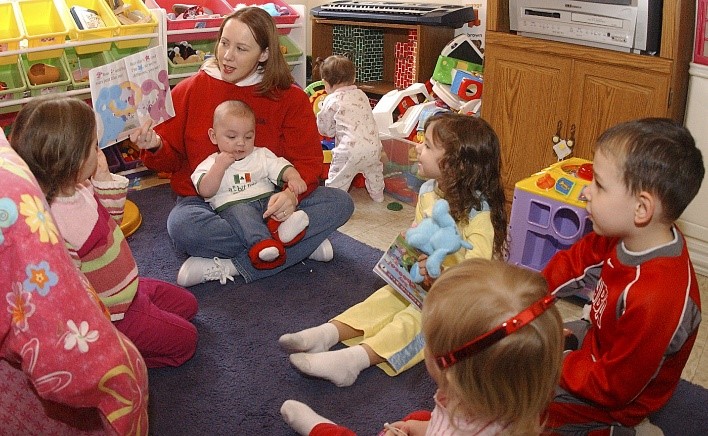
Each year, nationwide Head Start programs provide comprehensive early learning services to more than 1 million children from birth to age 5 through more than 60,000 classes, home visitors and family child care partners. In Nebraska, 21 grantees across the state provide services to more than 5,783 young children ages birth to age 5 and pregnant women. View grantee service areas in Nebraska
Since its inception in 1965, Head Start has been a leader in helping children from low-income families enter kindergarten better prepared to succeed in school and in life.
Head Start and Early Head Start are a central part of the nation’s effort to ensure young children have access to high-quality early learning opportunities and to eliminate the education achievement gap. Research shows that participation in high-quality early childhood programs have both short- and long-term effects on children’s social-emotional development as well as on math, literacy and language school readiness skills. In addition, participation in Head Start and Early Head Start has been shown to reduce grade retention, the need for special education services for children, teen pregnancy and engagement in criminal activity later in life.
Final revisions to the Head Start Program Standards, published in September 2016, had been nearly a decade in the making, fulfilling Congress’s call for a review and revision of the Program Performance Standards in the bipartisan Improving Head Start for School Readiness Act of 2007.
 The new standards were developed by incorporating the growing body of research on effective early care and education, consultation from subject matter experts and representatives from grantees and Indian tribes, and thoughtful consideration of the 1,000 public comments. The result is a new set of standards that reinforces Head Start’s position as a leader in the field of comprehensive early education, reflects best practices for teaching and local flexibility and reduces the number of federal requirements by approximately one-third. The standards apply to all Head Start and Early Head Start grantees, Tribal and Migrant programs and the newly funded Early Head Start-Child Care Partnership grants.
The new standards were developed by incorporating the growing body of research on effective early care and education, consultation from subject matter experts and representatives from grantees and Indian tribes, and thoughtful consideration of the 1,000 public comments. The result is a new set of standards that reinforces Head Start’s position as a leader in the field of comprehensive early education, reflects best practices for teaching and local flexibility and reduces the number of federal requirements by approximately one-third. The standards apply to all Head Start and Early Head Start grantees, Tribal and Migrant programs and the newly funded Early Head Start-Child Care Partnership grants.
Key Changes from Current Program Performance Standards
These new Head Start Program Performance Standards have been reorganized to make it easier for grantees to implement them and for the public to understand the broad range of Head Start program services. The new standards also do the following:
- Reduce regulatory burden and duplication by approximately 30%
- Increase regulatory transparency
- Shift focus from processes and plans to achievement of positive child and family outcomes
- Give individual programs more flexibility to design services around local community needs
Additional important changes to the standards include:
- Strengthening education services and curriculum requirements to ensure effective teaching in Head Start, based on the best research about how children learn and develop
- Clearly prohibiting expulsion of children and setting strict limitations on the use of temporary suspensions
- Implementation of coaching to build teacher skills and core competencies for home visitors

The majority of the standards went into effect November 7, 2016, however several key provisions have graduated implementation deadlines due to increased fiscal implications for programs—specifically the new standards focusing on increased program duration (increased classroom time), the addition of fingerprinting to required criminal background checks for staff and increased competency and certification requirements for staff working directly with families.
Expanding Time for Learning and Healthy Development
The increased duration may represent the most significant change to the standards. The increased duration is in direct response to recent research that shows increased program duration in a high-quality program is linked to better child outcomes. Currently, center-based Head Start pre-school programs are required to provide services for at least 3.5 hours per day for a minimum of 128 days per year. Below is a partial timeline for the changes relating to duration in the new standards:
- August 1, 2017, Early Head Start home-based programs must provide a minimum of one (1) home visit per week for at least 1.5 hours at a minimum of 46 visits per year, and provide, at a minimum, 22 group socialization opportunities for enrolled families over the program year
- August 1, 2018, Early Head Start center-based programs must provide a minimum of 1,380 annual hours of planned class operations for all enrolled children.
- August 1, 2019, Head Start center-based programs must provide a minimum of 1,020 annual hours of planned class operations for at least 50% of their funded enrollment.
- August 1, 2021, Head Start center-based programs must provide a minimum of 1,020 annual hours of planned class operations for 100% of their funded enrollment.
View the complete Performance Standard Timeline Compliance Table
Estimates for the cost of full implementation of the new Head Start Program Performance Standards by August 2021 are approximately $1 billion. In 2016, programs were offered partial funding to increase program duration as outlined above. If no additional funding is appropriated by Congress to meet the graduated implementation dates for program duration requirements, the HHS Secretary has the authority to adjust or modify the requirements. More information about the new Head Start Program Performance Standards
Stephanie Knust
Midland University
Dodge County Head Start Director
Fremont, Nebraska
Joan Luebbers
Head Start State Collaboration Office Director
Nebraska Department of Education
Lincoln, Nebraska


